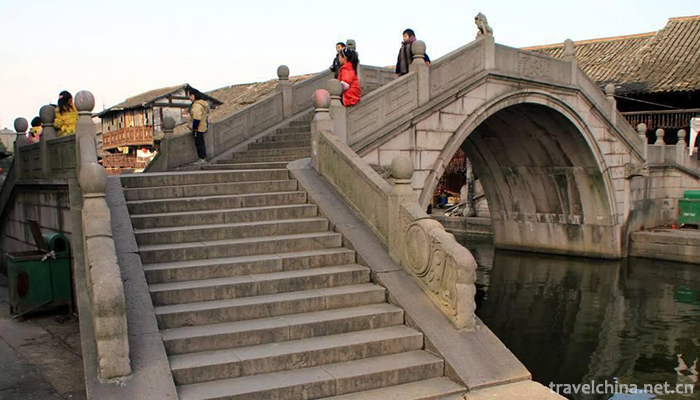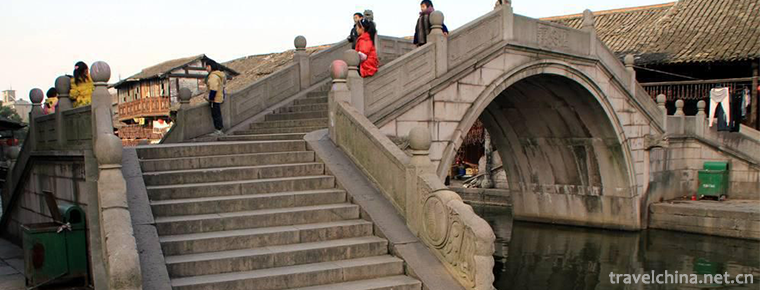Construction Techniques of Stone Bridge
Construction Techniques of Stone Bridge
Shiqiao construction technology, Shaoxing City, Zhejiang Province, local traditional architectural skills, one of the national intangible cultural heritage.
Shaoxing's ancient bridge construction techniques can be traced back to the Spring and Autumn Period and the Warring States Period. To the Han Dynasty, the stone arch bridge construction techniques became more and more mature, the bridge construction techniques in Tang and Song Dynasties improved continuously, and the stone bridge construction techniques in Qing Dynasty developed to the peak period.
In 2008, the Shiqiao construction technology declared by Shaoxing City, Zhejiang Province, was approved by the State Council of the People's Republic of China and listed in the second batch of national intangible cultural heritage list, project number_-176.
historical origin
Shaoxing's ancient bridge construction techniques should be traced back to the floating bridge and wooden beam bridge before the Spring and Autumn Period and the Warring States Period. During the Yue Guo Period, new components such as stone pillars, stone beams and stone bridge decks were used in the construction of ancient bridges because of the appearance of iron tools, which entered the initial period of stone beam bridge. By the Han Dynasty, stone arch bridge construction technology had been quite mature, and it was also applied in bridge construction in Shaoxing. The Qin and Han Dynasties were the period of the construction and development of Shaoxing Bridge. During the Tang and Song Dynasties, the canal and post roads in Shaoxing were smooth and the industry and commerce were developed, which made the construction techniques of bridges continuously improved. At the same time, the development of Shaoxing Stone Bridge entered its heyday.
By the Qing Dynasty, the construction technology of Shiqiao had reached its peak. Shaoxing Shiqiao is already quite large-scale. According to the "Shaoxing Fucheng Qu Road Map" drawn in 1893, there were 229 bridges in the city, with an average area of 7.4 square kilometers. There was a bridge every 0.0231 square kilometers. Stone bridges covered all parts of the city. Every short road, a stone bridge would be seen. "No bridge makes no city, no bridge makes no road, no bridge makes no village" is no exaggeration. At the end of 1993, there were 10 610 bridges in Shaoxing.
Technological characteristics
Shaoxing Shiqiao has unique construction skills. Some of the stone bridges (such as the Baziqiao, Guangning Bridge, etc.) are rare in China. Bridges in various forms form a very systematic technical system, which is in the leading level in the country at various times. Moreover, the construction technology of stone bridges is very scientific, the quality of materials is exquisite, the layout and site selection are reasonable, and the general life of ancient stone bridges can be more than a thousand years.
There are 704 stone bridges in Shaoxing, which is the largest number of stone bridges in one region of China. At the same time, Shaoxing is also one of the areas with the largest number of cultural relics protection units in Shiqiao. There are 13 ancient stone bridges in Shaoxing City, including ancient fibre road bridge, eight-way bridge, Guangxiang bridge, Guangning bridge, Silong bridge, Taiping bridge, Xie Gong bridge, Tifan bridge, Ying En bridge, Baiwang bridge, bridging bridge, Rongguang bridge, Jingkou bridge and West Lake bridge. There are 6 ancient stone bridges in provincial cultural relics protection units, such as Sanjiang Gate Bridge, and 38 ancient stone bridges in County (city) level cultural relics protection units, such as Longqiao.
Good quality: Shaoxing Shiqiao has 23 bridge types, constituting a complete series of stone bridges, some of which exist alone in Shaoxing and are no longer visible in other places. For example, in the "most technological construction of stone bridges", the Bazi Bridge, which was built in the Southern Song Dynasty, is the oldest existing urban bridge in China. The Guangning Bridge, which was built in the Southern Song Dynasty, is the oldest seven-fold-edged arch overpass in China. Yingxian Bridge and Yucheng Bridge are the earliest catenary Arch-Stone bridges in the Ming and Qing Dynasties. The ancient fibre road bridge is the only multi-bridge built along the river in the Tang Dynasty. Composite bridges and so on. Another example is the scientific arrangement of the soft soil foundation of Hutang Bridge in Han Dynasty unearthed from Shaoxing Lake, which is the earliest example of the soft soil foundation of China.
Longevity: The design life of contemporary bridges is about one hundred years, while the life of Shaoxing stone bridges can be more than one thousand years. This longevity originates from the scientific construction technology of Shaoxing Shiqiao, the quality of the stone materials and the reasonable layout and site selection. For example, the timber used in the construction of stone bridges is mostly pine, which has the reputation of "a thousand-year-old bottom pine". Pine is used as bridge columns and bridge piles can be preserved. The wooden piles unearthed in the foundation of Shaoxing Shiqiao are far from the Han Dynasty, and they can be well preserved when unearthed.
Inheritance and Protection
Inheritance value
Shaoxing Shiqiao not only creates superb skills, but also has profound cultural connotations, showing a very high aesthetic value. Its aesthetic feeling in environmental layout, structural decoration and other aspects makes people fully appreciate the unique magic charm of Jiangnan water culture. "Rainbow Jade comes with the door and the famous Wangu Bridge goes out of Yuezhou." Shaoxing Shiqiao culture has already become an important part of Yue culture.
Current situation of inheritance
In the market economy era, due to the high cost and complicated technology of stone bridge construction, general construction companies are reluctant to undertake construction. This makes Shaoxing Shiqiao construction technology gradually declining trend, inheritance of the lack of successors, and actively protect this advanced folk architectural technology has become an urgent task.
Heritage figures
Luoguanzhou, male, born in 1945. On November 5, 2009, Luoguanzhou was selected as the representative successor of the second batch of Shaoxing-level intangible cultural heritage projects. Shaoxing City, Zhejiang Province, declared the project: Shiqiao construction technology.
protective measures
On August 8, 2012, Zhejiang Sincerity Construction Co., Ltd. and Zhejiang Zhonglian Classical Garden Architecture Branch were selected to build a technology base for Shiqiao, and the construction technology of Shiqiao was protected.
On August 1, 2018, in the announcement of Shaoxing Municipal Bureau of Culture and Guangzhou and Shaoxing Bureau of Education on the recommendation list of the second batch of teaching heritage bases of Shaoxing intangible cultural heritage, Zhejiang Polytechnic Institute declared that it would build a technology base for Shiqiao.
On June 15, 2016, Luoguanzhou, the inheritor of "Shiqiao Construction Techniques", led nearly 100 teachers and students of Zhejiang Polytechnic of Industry to carry out on-the-spot survey of two ancient bridges in Jinghu New Area of Shaoxing.
social influence
Important Exhibitions
On September 3, 2014, the "Shiqiao Building Skills Exhibition" jointly organized by Shaoxing Science and Technology Association, Municipal Bureau of Culture and Guangzhou, Municipal Bureau of Cultural Relics and Municipal Ancient Bridge Society was held in the Municipal Cultural Museum. The Shiqiao Building Skills were displayed.


-
1.Mount Huangshan
Huangshan: World Cultural and Natural Heritage, World Geopark, National AAAAA Class Scenic Spot, National Scenic Spot, National Civilized Scenic Spot Demonstration Site, Top Ten Famous Mountains...
Time 2018-10-28 -
2.Wu zhen ancient town
Wuzhen, located in Tongxiang, Jiaxing City, Zhejiang Province, is located in the "Golden Triangle" of Jiangsu, Zhejiang and Shanghai
Time 2018-11-11 -
3.Alipay
Alipay (China) Network Technology Co., Ltd. is the third party payment platform in China. It is committed to providing a simple, safe and fast payment solution
Time 2018-11-13 -
4.Mount Maoshan
Maoshan is located in Jurong City, Zhenjiang City, Jiangsu Province. It is about 10 kilometers long from north to south, 5 kilometers wide from east to west, and covers an area of more than 50 square
Time 2018-12-06 -
5.Hefei Intangible Cultural Heritage Park
Hefei Intangible Cultural Heritage Park project is located in Changfeng County, Hefei City, China. The project covers an area of about 3500 mu, with a total investment of 500 million yuan and a constr
Time 2019-01-13 -
6.Changlu Tourist Xiubo Garden Scenic Area
Changlu Tourist Xiubo Park, or Changlu Environmental Resort Farm (hereinafter referred to as "Changlu Farm"), became the national 5A scenic spot in November 2014. It is the only national 5A
Time 2019-03-17 -
7.Zhenjiang Jinshan Temple
Jinshan Temple was built in Jinshan Mountain on the South Bank of the Yangtze River in Zhenjiang City, Jiangsu Province, at the time of Emperor Ming of the Eastern Jin Dynasty
Time 2019-03-18 -
8.Cham
The Yi epic, recorded in the old Yi language and widely circulated, describes the origin of all things in the Yi legend. The Yi people call it a "search" to describe the origin of a thing be
Time 2019-04-15 -
9.Spring Festival
The Spring Festival, the Lunar New Year, is the first year of the year and also the traditional "New Year's Day". Commonly known as New Year, Spring Festival has a long history
Time 2019-04-22 -
10.Laiwu Bangzi
Laiwu Bangzi, also known as Laiwu Bangzi, is a unique opera in China. It has a history of more than 200 years and is a wonderful flower in traditional Chinese local operas.
Time 2019-05-10 -
11.Bamboo and Wood Instrument Music of Li Nationality
The traditional instrumental music of Li Nationality is based on abundant bamboo and wood resources, including solo music, ensemble music, song and dance music, sacrificial music and eight kinds of mu
Time 2019-05-13 -
12.Corn and sparerib soup
Corn and spareribs soup is a tonic soup, the main ingredients are corn and spareribs, the main cooking technology is stew. Corn can reduce the blood cholesterol concentration and prevent it from depos
Time 2020-03-16